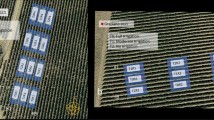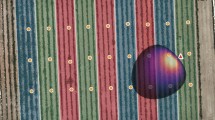Abstract
Water status directly affects yield and crop quality in grapevines. Precision viticulture demands the application of new available technologies and methodologies for accurate irrigation management in vineyards. The objective of this work was the development of an on-the-go thermal imaging application for the assessment and map** of vineyard water status, building a dataset from a commercial Tempranillo (Vitis vinifera L.) vineyard over two consecutive seasons and validating it in another commercial vineyard from a different winegrowing region. Thermal imaging was performed with a thermal camera mounted in an all-terrain vehicle, moving at 5 km/h and operating at a distance from the canopy of 1.20 m. Stem water potential (Ψstem) was used for validation as the grapevine water status reference method, using a Scholander pressure chamber. Crop Water Stress Index (CWSI) and Stomatal Conductance Index (Ig) from a 4-day dataset were computed and correlated with Ψstem, delivering significant (p < 0.0001) determination coefficients R2 up to 0.71. The prediction capability of this dataset was also validated in another commercial vineyard, achieving a prediction R2 up to 0.82 (RMSE of 0.123 MPa). The predicted values of both indices were thus employed for map** vineyard water status in the second plot. These results evidence the potential applicability of on-the-go thermal imaging for assessing and map** water status in commercial vineyards required for precision viticulture.





Similar content being viewed by others
References
Acevedo-Opazo C, Tisseyre B, Guillaume S, Ojeda H (2008) The potential of high spatial resolution information to define within-vineyard zones related to vine water status. Precision Agric 9:285–302
Acevedo-Opazo C, Tysseire B, Taylor J, Ojeda H, Guillaume S (2010) Spatial prediction model of the vine (Vitis vinifera L.) water status using high resolution ancillary information. Precision Agric 11:358–378
Alchanatis V, Cohen Y, Cohen S, Moller M, Sprinstin M, Meron M, Tsipris J, Saranga Y, Sela E (2010) Evaluation of different approaches for estimating and map** crop water status in cotton with thermal imaging. Precision Agric 11:27–41
Balafoutis AT, Koundouras S, Anastasiou E, Fountas S, Arvanitis K (2017) Life cycle assessment of two vineyards after the application of precision viticulture techniques: a case study. Sustainability 9:1997
Baluja J, Diago MP, Balda P, Zorer R, Meggio F, Morales F, Tardaguila J (2012) Assessment of vineyard water status variability by thermal and multispectral imagery using an unmanned aerial vehicle (UAV). Irrig Sci 30:511–522
Bellvert J, Zarco-Tejada PJ, Girona J, Fereres E (2014) Map** crop water stress index in a ‘Pinot-noir’ vineyard: comparing ground measurements with thermal remote sensing imagery from an unmanned aerial vehicle. Precision Agric 15:361–376
Bellvert J, Marsal J, Girona J, Zarco-Tejada PJ (2015) Seasonal evolution of crop water stress index in grapevine varieties determined with high-resolution remote sensing thermal imagery. Irrig Sci 33:81–93
Bellvert J, Zarco-Tejada PJ, Marsal J, Girona J, González-Dugo V, Fereres E (2016) Vineyard irrigation scheduling based on airborne thermal imagery and water potential thresholds. Aust J Grape Wine Res 22:307–315
Choné X, Van Leeuwen C, Dubourdieu D, Gaudillère JP (2001) Stem water potential is a sensitive indicator of grapevine water status. Ann Bot 87:477–483
Cohen Y, Alchanatis V, Meron M, Saranga Y, Tsipris J (2005) Estimation of leaf water potential by thermal imagery and spatial analysis. J Exp Bot 56:1843–1852
Cohen Y, Alchanatis V, Prigo** A, Levi A, Soroker V (2012) Use of aerial thermal imaging to estimate water status of palm trees. Precision Agric 13:123–140
Cohen Y, Alchanatis V, Sela E, Saranga Y, Cohen S, Meron M, Bosak A, Tsipris J, Ostrovsky V, Orolov V et al (2015) Crop water status estimation using thermography: Multi-year model development using ground-based thermal images. Precision Agric 16:311–329
Cohen Y, Alchanatis V, Saranga Y, Rosenberg O, Sela E, Bosak A (2017) Map** water status based on aerial thermal imagery: comparison of methodologies for upscaling from a single leaf to commercial fields. Precision Agric 18:801–822
Costa JM, Grant OM, Chaves MM (2010) Use of thermal imaging in viticulture: current application and future prospects, Methodologies and results in grapevine research. Springer
Costa JM, Grant OM, Chaves MM (2013) Thermography to explore plant–environment interactions. J Exp Bot 64:3937–3949
Costa JM, Vaz M, Escalona J, Egipto R, Lopes C, Medrano H, Chaves MM (2016) Modern viticulture in southern Europe: vulnerabilities and strategies for adaptation to water scarcity. Agric Water Manag 164:5–18
Costa JM, Egipto R, Sánchez-Virosta A, Lopes CM, Chaves MM (2019) Canopy and soil thermal patterns to support water and heat stress management in vineyards. Agric Water Manag 216:484–496
Crusiol LGT, Nanni MR, Furlanetto RH, Sibaldelli RNR, Cezar E, Mertz-Henning LM, Nepomuceno AL, Neumaier N, Farias JRB (2020) UAV-based thermal imaging in the assessment of water status of soybean plants. Int J Remote Sens 41:3243–3265
Diago MP, Fernández-Novales J, Gutiérrez S, Marañón M, Tardaguila J (2018) Development and validation of a new methodology to assess the vineyard water status by on-the-go near infrared spectroscopy. Front Plant Sci 9:59
Fernández JE (2014) Plant-based sensing to monitor water stress: applicability to commercial orchards. Agric Water Manag 142:99–109
Fernández-Novales J, Tardáguila J, Gutiérrez S, Paz Diago M (2019) On-The-Go VIS + SW - NIR spectroscopy as a reliable monitoring tool for grape composition within the vineyard. Molecules (Basel, Switzerland) 24:2795
Fuentes S, De Bei R, Pech J, Tyerman S (2012) Computational water stress indices obtained from thermal image analysis of grapevine canopies. Irrig Sci 30:523–536
Gonzalez-Dugo, V., Zarco-Tejada, P.J., Intrigliolo, D.S., Ram\’\irez-Cuesta, J.-M., 2020. Normalization of the crop water stress index to assess the within-field spatial variability of water stress sensitivity. Precision Agriculture 1–20.
Grant OM, Tronina Ł, Jones HG, Chaves MM (2006) Exploring thermal imaging variables for the detection of stress responses in grapevine under different irrigation regimes. J Exp Bot 58:815–825
Grant OM, Ochagavía H, Baluja J, Diago MP, Tardáguila J (2016) Thermal imaging to detect spatial and temporal variation in the water status of grapevine (Vitis vinifera L.). J Hortic Sci Biotechnol 91:43–54
Gutiérrez S, Diago MP, Fernández-Novales J, Tardaguila J (2018) Vineyard water status assessment using on-the-go thermal imaging and machine learning. PLoS ONE 13:0192037
Harrison-Murray RS (1991) An electrical sensor for potential transpiration: principle and prototype. J Horticultic Sci 66:141–149
Hinkelmann K, Kempthorne O (2007) Randomized block designs, in design and analysis of experiments: introduction to experimental design. John Wiley & Sons Inc
Idso SB, Jackson RD, Pinter PJ, Reginato RJ, Hatfield JL (1981) Normalizing the stress-degree-day parameter for environmental variability. Agric Meteorol 24:45–55
Intrigliolo DS, Castel JR (2008) Effects of irrigation on the performance of grapevine cv. Tempranillo in Requena, Spain. Am J Enol Vitic 59:30–38
Intrigliolo DS, Lakso AN (2009) Effects of light interception and canopy orientation on grapevine water status and canopy gas exchange. In: VI International Symposium on Irrigation of Horticultural Crops 889:99–104
Jones HG (1999) Use of infrared thermometry for estimation of stomatal conductance as a possible aid to irrigation scheduling. Agric For Meteorol 95:139–149
Jones HG (2002) Use of infrared thermography for monitoring stomatal closure in the field: application to grapevine. J Exp Bot 53:2249–2260
Jones HG (2004) Irrigation scheduling: advantages and pitfalls of plant-based methods. J Exp Bot 55:2427–2436
Karvatte N, Miyagi ES, de Oliveira CC, Barreto CD, Mastelaro AP, Bungenstab DJ, Alves FV (2020) Infrared thermography for microclimate assessment in agroforestry systems. Sci Total Environ 731:139252
Keller M (2015) The science of grapevines: anatomy and physiology. Academic Press
Knipper KR, Kustas WP, Anderson MC, Alsina MM, Hain CR, Alfieri JG, Prueger JH, Gao F, McKee LG, Sanchez LA (2019) Using high-spatiotemporal thermal satellite ET retrievals for operational water use and stress monitoring in a California vineyard. Remote Sens 11:2124
Lee S, Wolberg G, Shin SY (1997) Scattered data interpolation with multilevel B-splines. IEEE Trans Visual Comput Graphics 3:228–244
Meron M, Tsipris J, Orlov V, Alchanatis V, Cohen Y (2010) Crop water stress map** for site-specific irrigation by thermal imagery and artificial reference surfaces. Precision Agric 11:148–162
Ortega-Farías S, Ortega-Salazar S, Poblete T, Kilic A, Allen R, Poblete-Echeverría C, Ahumada-Orellana L, Zuñiga M, Sepúlveda D (2016) Estimation of energy balance components over a drip-irrigated olive orchard using thermal and multispectral cameras placed on a helicopter-based unmanned aerial vehicle (UAV). Remote Sens 8:638
Pagay V, Kidman CM (2019) Evaluating remotely-sensed grapevine (Vitis vinifera L.) water stress responses across a viticultural region. Agronomy 9:682
Petrie PR, Wang Y, Liu S, Lam S, Whitty MA, Skewes MA (2019) The accuracy and utility of a low cost thermal camera and smartphone-based system to assess grapevine water status. biosystems engineering. Biosyst Eng 179:126–139
Pou A, Diago MP, Medrano H, Baluja J, Tardaguila J (2014) Validation of thermal indices for water status identification in grapevine. Agric Water Manag 134:60–72
Scholander PF, Bradstreet ED, Hemmingsen EA, Hammel HT (1965) Sap pressure in vascular plants negative hydrostatic pressure can be measured in plants. Science 148:339–346
Sepúlveda-Reyes D, Ingram B, Bardeen M, Zúñiga M, Ortega-Farías S, Poblete-Echeverría C (2016) Selecting canopy zones and thresholding approaches to assess grapevine water status by using aerial and ground-based thermal imaging. Remote Sens 8:822
Van Leeuwen C, Trégoat O, Choné X, Bois B, Pernet D, Gaudillère JP (2009) Vine water status is a key factor in grape ripening and vintage quality for red Bordeaux wine. How can it be assessed for vineyard management purposes? OENO One 43:121–134
Acknowledgements
The work leading to these results has received funding from the European Union under grant agreement nº 737669 (VineScout project). The authors acknowledge Daniel Sepúlveda and Marioli Carrasco for their help with the measurement of the stem water potential. Special thanks to Bodegas Vivanco and Pago de Carraovejas for providing the vineyards to conduct the study.
Author information
Authors and Affiliations
Corresponding author
Additional information
Publisher's Note
Springer Nature remains neutral with regard to jurisdictional claims in published maps and institutional affiliations.
Rights and permissions
About this article
Cite this article
Gutiérrez, S., Fernández-Novales, J., Diago, MP. et al. Assessing and map** vineyard water status using a ground mobile thermal imaging platform. Irrig Sci 39, 457–468 (2021). https://doi.org/10.1007/s00271-021-00735-1
Received:
Accepted:
Published:
Issue Date:
DOI: https://doi.org/10.1007/s00271-021-00735-1




